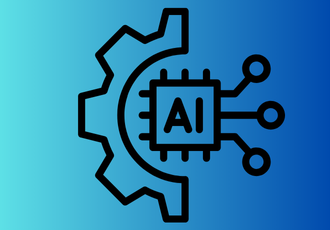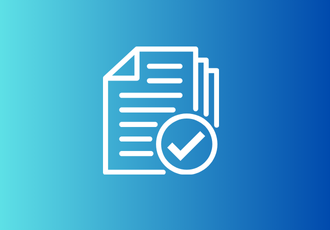As you read this sentence, AI agents are already at work, streamlining operations, answering customer inquiries, and analyzing vast amounts of data – personal AI assistants are the new norm.
With a market set to reach $1.3 trillion by 2030, AI automation is indeed driving the decline of banal and repetitive tasks, transforming operations and unlocking opportunities.
So what is AI-powered automation, and how can your business benefit from it? Let’s get into it.
What is AI Automation?
Artificial intelligence automation or AI automation is the fusion of artificial intelligence and automation, designed to handle repetitive tasks with minimal human intervention. It adapts using machine learning, natural language processing, and predictive analytics, making it more flexible, dynamic, and capable of handling complex workflows.
Automation started with robots performing simple tasks, known as robotic process automation (RPA). Over time, this evolved into intelligent automation (IA), which connects RPA with AI and business process management (BPM). IA streamlines end-to-end processes, allowing businesses to optimize operations across systems.
For businesses, AI automation delivers clear benefits: cutting inefficiencies, reducing errors, and improving decision-making. It not only predicts problems before they occur but also personalizes customer experiences and makes strategic recommendations.
How Does AI Automation Work?
AI automation leverages machine learning and advanced algorithms to analyze data and make decisions that drive task automation.
The process starts with data ingestion – AI gathers and analyzes both structured and unstructured data from various sources. Machine learning models then uncover insights, detect anomalies, and predict future trends. Based on this intelligence, automation tools execute tasks, reducing the need for manual oversight.
For instance, Downer simplified their most complex process, the Permit to Dig, using FlowForma’s AI-powered automation. A previously manual, paper-based task mandating multiple approvals has been transformed into a streamlined digital workflow.
By integrating digital forms with GIS (Geographic Information System) data, FlowForma helped Downer push real-time information to field teams via handheld devices. Teams now receive the right information at the right time, allowing them to make faster, safer decisions and significantly reduce the risk of service strikes.
AI vs automation: what’s the difference?
Automation relies on fixed instructions to handle repetitive, structured tasks like data entry or invoice processing. It follows strict rules but lacks flexibility and adaptability.
AI, on the other hand, brings intelligence into the process. It analyzes large datasets, identifies patterns, and evolves over time. These systems can handle ambiguity, learn from experience, and make independent decisions.
Consider a customer service chatbot: a basic bot follows a script, while an AI-powered bot understands intent, learns from each interaction, and continuously improves its responses. The difference? One is static; the other adapts and refines itself.
In short, automation boosts speed and efficiency, while AI infuses adaptability and intelligence, making processes smarter and more dynamic.
In a recent webinar I hosted, I discussed the interaction of AI and process automation and how to strike the right balance for your organization. Check out the recording here below.
Benefits of AI Automation in Business Processes
 Benefits of AI Automation in Business Processes
Benefits of AI Automation in Business Processes
Following are five key benefits of AI automation for businesses:
1. Improve productivity and reduce costs
From data entry to customer inquiries, AI takes care of routine work, freeing up teams to focus on strategic initiatives. According to McKinsey, AI automation can slash labor costs by 30% for several industries. This allows operating more efficiently with smaller teams while maintaining high levels of accuracy and output.
2. Detecting anomalies and risks proactively
AI-driven monitoring systems enhance risk management by identifying anomalies in real time for a proactive response. Advanced technologies now provide comprehensive visibility, enabling companies to anticipate disruptions and streamline operations.
3. End-to-end supply chain visibility
Only 60% of suppliers have a comprehensive visibility of their tier-one suppliers. This can lead to inefficiencies and compliance risks. AI-powered tools provide real-time insights by mapping complex supplier networks, identifying vulnerabilities, and ensuring regulatory compliance.
For example, Semantic Visions uses its AI-driven mapping tool to analyze vast amounts of global data in real-time. This helps quickly spot vulnerable supplier relationships and identify compliance risks and ESG violations.
4. Cross-departmental collaboration
AI process automation streamlines workflows, reduces manual tasks, and enhances team collaboration by providing real-time insights and facilitating seamless communication. For instance, the Liverpool School of Tropical Medicine (LSTM) implemented FlowForma's platform to replace paper-based processes, resulting in improved cross-departmental collaboration and operational efficiency. Staff proactively sought ways to enhance their practices, leading to a more collaborative environment.
5. Faster process automation with AI Assistant
With the rise of AI, process automation now offers 24/7 assistance, providing answers to process-related questions, guiding automation, analyzing data, and ensuring workflows run smoothly. This makes the entire experience faster and more efficient.
Challenges of AI Automation
 Three challenges of AI automation
Three challenges of AI automation
Although AI in automation is beneficial for streamlining operations, it instigates several challenges, necessitating businesses to address them.
1. AI bias and decision transparency
AI models learn from historical data, which can embed biases and lead to unfair outcomes. In hiring, for example, an AI-powered recruitment tool trained on past trends may unintentionally favor certain demographics, limiting diversity.
The bigger issue? Many AI models function as “black boxes”, in which decisions are made without clear explanations. Without transparency, businesses can’t identify or correct biases. Ensuring fairness requires explainable AI, regular audits, and diverse training datasets.
3. Security vulnerabilities in automated workflows
AI automation introduces new security risks, as automated systems handle sensitive data, making them prime targets for cyberattacks. Hackers can exploit AI weaknesses, manipulate decision-making models, or inject harmful data.
For instance, an AI fraud detection system could be compromised by misleading data, allowing fraudulent transactions to go undetected. AI-powered customer service bots can also be tricked into revealing confidential information. Businesses must prioritize continuous AI monitoring, strict access controls, and regular security updates to mitigate these threats.
3. Bad data to feed AI models
The data you provide to AI models directly impacts their outputs. Using incorrect or corrupted data can cause major problems with your AI platform down the line. This is why process automation serves as an ideal foundation for your AI journey. With process automation, you can gather, standardize, and securely store your data in the cloud. AI models built on this "clean" data will be better equipped to scale your AI initiatives.
6 AI Automation Use Cases Across the Industry
Let us take you through six compelling AI automation use cases across various sectors:
Manufacturing
Predictive maintenance is transforming manufacturing by using AI to anticipate equipment failures before they happen. This allows companies to address issues early, minimizing downtime and improving efficiency. For example, BMW Group’s Regensburg plant uses AI and automation to analyze data from conveyor systems, detecting anomalies like power fluctuations.
AI also optimizes inventory by analyzing historical sales data and market trends, helping manufacturers maintain ideal stock levels and avoid overproduction or shortages. Additionally, it automates site inspections and compliance audits, ensuring strict regulatory adherence while reducing manual oversight.
HR onboarding
AI accelerates onboarding processes by automating repetitive tasks like document verification, resume parsing, assigning IT access, tracking compliance, contract signing, and much more.
With tools like FlowForma’s AI-powered process automation, HR teams can focus on engaging new hires instead of chasing paperwork, ensuring productivity and integration of new hires.
In this interactive video, FlowForma Copilot builds on onboarding process in recruitment. This is a great example of AI in action, creating a process in minutes instead of the hours or days it would have taken before.
Healthcare
AI is significantly improving patient care and diagnostics by helping healthcare providers detect diseases earlier and more accurately.
For example, AI-driven tools are used to analyze medical images like CT scans and X-rays, detecting conditions such as cancer and other abnormalities with high precision. Additionally, AI models have been deployed in intensive care units (ICUs) to predict patient deterioration, enabling faster, more proactive care.
Beyond detection and diagnostics, AI automation allows hospital staff and clinicians to focus on patient care by automating lengthy paperwork and tedious workflows. For instance, with FlowForma’s AI-powered automation, Blackpool Teaching Hospitals gained a time-saving approach, improving accuracy, and reducing the administrative and clinical burden
 A customer from FlowForma's NHS customer
A customer from FlowForma's NHS customer
Energy
Dresser Natural Gas Solutions (NGS), a leading provider of measurement and piping solutions, standardized and accelerated compliance tracking and document management using FlowForma. By automating critical administrative processes, companies like NGS can focus on optimizing energy delivery and ensuring grid reliability.
Banking and financial services
Integrating AI-driven automation has significantly enhanced operational efficiency in the banking sector. These systems assist financial institutions in automating transaction monitoring, risk assessment, and incident reporting, thereby aiding compliance with regulations such as the Digital Operational Resilience Act (DORA).
Moreover, AI plays a critical role in detecting and preventing fraud by analyzing transaction patterns in real time. Machine learning algorithms can identify anomalies and flag suspicious activities, helping banks detect fraudulent behavior more quickly and accurately.
Insurance
AI is revolutionizing the insurance industry by automating key processes like claims processing, fraud detection, and underwriting. For example, Aon leveraged FlowForma to automate critical tasks such as GDPR requests and regulatory audits, improving transparency, efficiency, and ensuring compliance.
With AI assistants, processes such as Insurance Claims can be built in minutes compared with traditional process building. In this interactive demo below you'll see how fast and simple it can be to build out an insurance claims process with FlowForma Copilot.
The Future of Work and AI Automation
The World Economic Forum’s Future of Jobs Report 2025 predicts a net increase of 78 million new jobs by 2030, as businesses balance automation with workforce transformation. Automation and AI are redefining the workplace, driving efficiency, and reshaping job roles. Here’s a closer look at what’s coming:
1. Automation of routine tasks
AI is taking over repetitive tasks such as data entry, scheduling, and compliance tracking. This allows employees to focus on high-value work that requires creativity, critical thinking, and emotional intelligence. As routine processes become automated, organizations can reduce operational costs while improving accuracy and efficiency.
2. Shifting job roles and skill demands
As AI automates repetitive functions, job roles will shift. The growing demand for AI and automation literacy means employees must reskill and focus on developing strategic, creative, and tech-centric capabilities.
3. Human-AI collaboration
The future isn’t about replacing humans but creating a seamless partnership between human expertise and AI intelligence. For instance, if AI-powered tools handle routine customer service queries, human agents can use their free time to address complex issues that require empathy and critical thinking.
How FlowForma Helps Achieve Operational Excellence with AI Automation
FlowForma empowers organizations to optimize workflows and improve operational efficiency by combining AI with its no-code process automation platform. Here’s how:
No-Code automation
FlowForma's no-code platform enables teams to automate complex processes without IT expertise, leading to faster deployment and reduced dependency on IT resources.
Enhanced decision-making with AI
FlowForma’s AI Assistants analyze vast amounts of data in real time, providing actionable insights that guide faster, data-driven decision-making. This reduces delays and ensures teams can respond to changes quickly and effectively.
Besides, it leverages Generative AI and Agentic AI to streamline workflow design and execution, enabling users to swiftly map out and implement automation strategies.
Improving workflow transparency and collaboration
FlowForma enhances collaboration by providing real-time tracking and reporting features, offering clear visibility into task assignments, progress, and completion statuses. This visibility fosters accountability among team members and allows managers to identify inefficiencies, resolve issues quickly, and improve team coordination.
Seamless integration with existing systems
FlowForma integrates effortlessly with existing business systems, ensuring a smooth flow of information across departments. This eliminates data silos and enhances cross-functional collaboration.
Continuous improvement and scalability
FlowForma’s AI-driven insights help identify process bottlenecks and recommend improvements. As organizations scale, FlowForma’s automation grows with them, ensuring continuous process optimization and long-term operational agility.
Experience all these benefits of AI automation firsthand with FlowForma by starting your 7-day free trial today.
 By
By 



